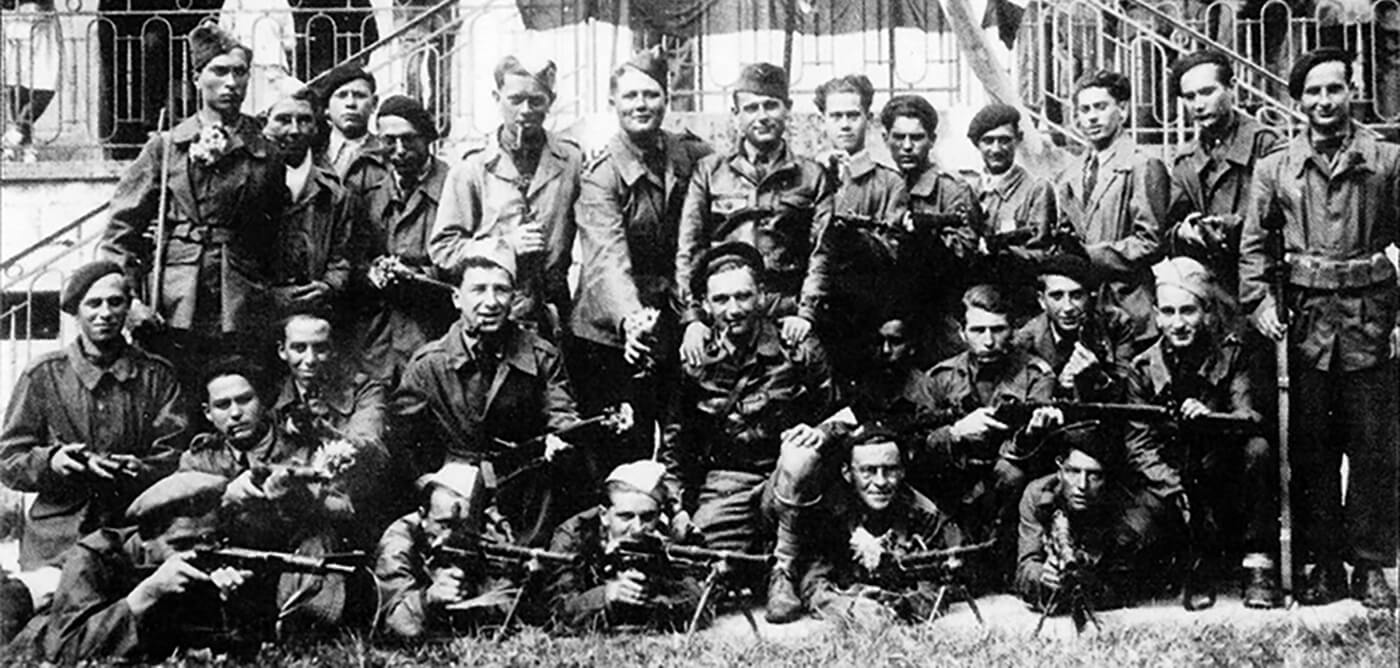| Page Created |
| March 3rd, 2024 |
| Last Updated |
| March 3rd, 2024 |
| France |
 |
| Additional Information |
| Unit Order of Battle Commanders Operations Equipment Multimedia References Biographies |
| Badge |
 |
| Motto |
| Fault Pas y Crainsdre |
| Founded |
| September 4th, 1944 |
| Disbanded |
| October 1st, 1945 |
| Theater of Operations |
| France Germany |
| Organisational History |
The battalion is raised as the Commando de Cluny on September 4th, 1944, with volunteers from the Régiment de Cluny. The Régiment de Cluny originates from a Françaises de l’Intérieur resistance group also known as Maquis hailing from Cluny, under the leadership of Commander Laurent Bazot.
Bazot requests General de Lattre de Tassigny to accept the formation of the Cluny Commando. The General accepts them on September 13th, 1944. By September 16th, 1944, a significant portion of Sylla’s maquis, predominantly consisting of Montcellian miners, have joined the ranks of the Cluny Commando de Cluny. Shortly afterwards the men commence their rigorous training at the Camp Bergesserin, a former sanatorium, in the Saône-et-Loire region.
On September 20th, 1944, the Commando de Cluny is formally integrated into the French 1er Armée under the command of General de Lattre de Tassigny, boasting a strength of 650 men. The unit comprising three companies led by Captain Du Chaffaut, Captain Prost, and Captain Fruitier, respectively. Additionally, it includes a non-rank company under the command of Commander Broyer, and a Frank group led by Lieutenant Fontaine. Headquarters is composed of Captain Dubois and Captain Loizillon, along with Lieutenant D’Halle and Lieutenant Jacquet.
Until September 21st, 1944, the Commando de Cluny is stationed in Camp Bergesserein, initially attached to the 1re Division de Marche Indigène and later to the 9e Division d’Infanterie Coloniale. From September 21 to 26, the Companies are directed to Avannes Avenay (southwest of Besançon) for patrol missions in the Medières – La Pretière – Longevelle sector.
On October 4th, 1944, the unit suffers losses of 6 men (2 dead and 4 wounded) during an engagement. Various patrols, engagements, and liaison missions are carried out in the same sector until October 29th, 1944, when all Companies are directed to Valdahon for a period of instruction, lasting until November 10th, 1944.
On October 17th, 1944, an attack on Vacheresse, near Belfort, is launched. Despite minefields, faulty communications, and lack of supplies, the Commando de Cluny achieves its objectives (2 injured). The advance resumes on the October 18th, 1944, resulting in 3 dead and 3 injured due to mines. The next day, while the attack continues, a detachment is sent to the Champagney Dam, resulting in the loss of 30 men (9 dead, 19 wounded, and 2 prisoners), despite achieving the objective.
Under the command of Commander Laurent Bazot, on November 18th, 1944, the Commando de Cluny launches an assault on Chenebier.
On November 23rd, 1944, the commando is placed at the disposal of the 2e Division d’Infanterie Marocaine and moves towards Belfort, which is under German control. On the November 25th, 1944, it moves into the forts of Belfort to defend them and ensure the security of the city.
On December 2nd, 1944, the commando attacks Côte 475 in Bourbach le Bas (Haut-Rhin). Despite reaching the crest initially, they are forced to abandon it due to enemy resistance and lack of artillery and tanks. The day results in 7 dead and 4 wounded. The next day, the enemy counterattacks but is repelled by artillery. From December 3rd, 1944, to December 6th, 1944, the commando remains in position. On December 7th, 1944, it changes sectors to relieve other elements, preparing for an attack on Rammersmatt the following day.
On December 8th, 1944, the Commando de Cluny begins its progression, facing resistance from an entire German battalion defending the Kürrenburg. Progress is slow and difficult, resulting in 6 dead and 9 injured. The men destroy a Jagdpanther. The next day, the Germans retreat, and the Kürrenburg is taken. Finally giving the unit the needed rests.
However, a few days later, on December 11th, 1944, they move to Thann, where the enemy is installed, and is relieved, one day later, on the December 12th, 1944, before returning on the December 19th, 1944. During the night of the December 20th, 1944, the Germans launch an offensive, repulsed by the Commandos de Cluny at the cost of one dead and one wounded.
On December 24th, 1944, the men witness German soldiers carrying a cannon at close range, resulting in 7 dead and 12 wounded. The soldiers spend Christmas Day and the December 31st, 1944, in their positions, repelling enemy infiltrations suffering one dead and five wounded.
On January 5th, 1945, several units are reorganised into six Bataillons de Choc. The original Bataillon de Choc becomes the 1er Bataillon de Choc, 1er Choc. The Janson de Sailly Batallion is reformed as the 2e Bataillon de Choc, 2e Choc. The Commandos de France are transformed into the 3e Bataillon de Choc, 3e Choc. The Commandos de Cluny establish the 4e Bataillon de Choc, 4e Choc. The Groupement de Commandos d’Afrique is reorganised into the 5e Bataillon de Choc, 5e Choc under Commander Ducournau, while the Commandos de Provence and the Commandos de Paris/Bataillon Désiré become the 6e Bataillon de Choc, 6e Choc.
At that moment, only 250 men are still fit to fight. The next day, the battalion is sent to Etupes for a well-deserved rest. Between January 16th, 1945, and February 4th, 1945, the 4e Bataillon de Choc is fortified by reinforcements from the 5e and 8e Forces Françaises de l’Intérieur Bataillons de Saône-et-Loire. Raising the battalion’s ranks to nine hundred men.
On 18th January 1945, these six Bataillons de Choc form three Groupements de Commandos de Choc, each comprising two Bataillons.
- The 1re Groupement de Commandos de Choc, led by Lieutenant Colonel Gambiez, includes the 1re and 3e Bataillon de Choc.
- The 2e Groupement de Commandos de Choc, under Commander Quinche, consists of the 2e and 4e Bataillon de Choc.
- The 3e Groupement de Commandos de Choc, commanded by Lieutenant Colonel Bouvet, encompasses the 5e and 6e Bataillon de Choc.
That very same day, it moves to Rouffach for an 8-day training period and continues training until April 2nd, 1945, when the battalion receives orders to be ready to move towards Germany.
On April 4th, 1945, the battalion crosses the River Rhine into German territory. From the April 4th, 1945, to the April 9th, 1945, the battalion patrols an indifferent or even hostile German region. A man is killed by a sniper. On April 20th, 1945, the Battalion, impatient to resume the fight, is placed at the disposal of the French 1re Division Blindée. In the following days, the Battalion navigates a confused front where German Prisoners of War have freed themselves and taken up arms, and where other German troops are retreating.
The Battalion is stationed in the Buchau region and conducts clearing patrols. When it leaves this region on May 2nd, 1945, 1750 prisoners are handed over to the 1re Division Blindée, and the region is pacified and cleansed. However, vigilance is still required, as there are still a few German soldiers who believe in the victory of the Reich. Thus, on May 4th, 1945, a soldier from the Battalion is killed by a sniper.
Following Germany’s capitulation, the Groupements de Commandos are stationed in the Ravensburg area, Gemany. Here they are part of the French occupation forces of Germany. Throughout the following months of May and June, the battalion engages in training, sports activities, military police operations, and occasional parades or readiness exercises.
The 2e Compagnie concludes the campaign by serving as the honour guard for Marshal De Lattre de Tassigny.
On October 1st, 1945, the three Groupements de Commandos de Choc are reformed to the three Bataillons of the 1er Régiment d’Infanterie de Choc Aéroporté, 1er RICAP near Wurtemberg, Germany.
- 1er bataillon: consisting of the 1er Bataillon de Choc and 2e Bataillon de Choc.
- 2e bataillon: consisting of the 5e Bataillon de Choc and 6e Bataillon de Choc.
- 3e bataillon: consisting of the 3e Bataillon de Choc and 4e Bataillon de Choc.
After this date, the units move back to France, to the vicinity La Pallu near Bordeaux.
During its existence, the unit suffers around 250 killed and actions and a multitude of wounded.

